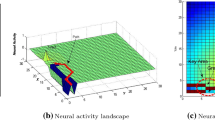Abstract
Cognitive robotics aims at understanding biological processes, though it has also the potential to improve future robotics systems. Here we show how a biologically inspired model of motor control with neural fields can be augmented with additional components such that it is able to solve a basic robotics task, that of obstacle avoidance. While obstacle avoidance is a well researched area, the focus here is on the extensibility of a biologically inspired framework. This work demonstrates how easily the biological inspired system can be used to adapt to new tasks. This flexibility is thought to be a major hallmark of biological agents.
Access this chapter
Tax calculation will be finalised at checkout
Purchases are for personal use only
Similar content being viewed by others
References
Amari, S.: Dynamics of pattern formation in lateral-inhibition type neural fields. Biol. Cybern. 27(2), 77–87 (1977)
Bicho, E., Louro, L., Erlhagen, W.: Integrating verbal and nonverbal communication in a dynamic neural field architecture for human-robot interaction. Front. Neurorobot. 4, 5 (2010). doi:10.3389/fnbot.2010.00005
Borenstein, J., Koren, Y.: The vector field historgram - fast obstacle avoidance for mobile robots. IEEE Trans. Robot. Autom. 7(3), 278–288 (1991)
Connors, W., Trappenberg, T.: Improved path integration using a modified weight combination method. Cogn. Comput. 5(3), 295–306 (2013)
Engels, C., Schöner, G.: Dynamic fields endow behavior-based robots with representations. Robot. Auton. Syst. 14(1), 55–77 (1995)
Fard, F.S., Hollensen, P., Heinke, D., Trappenberg, T.P.: Modeling human target reaching with an adaptive observer implemented with dynamic neural fields. Neural Netw. 72, 13–30 (2015)
Iossifidis, I., Steinhage, A.: Controlling an 8 DOF manipulator by means of neural fields. In: Proceedings of the International Conference on Field and Service Robotics. FSR 2001, Helsinki, Finland (2001)
Khansari-Zadeh, S.M., Billard, A.: A dynamical system approach to realtime obstacle avoidance. Auton. Robots 32(4), 433–454 (2012)
Khatib, O.: Real-time obstacle avoidance for manipulators and mobile robots. In: Proceedings of the IEEE International Conference on Robotics and Automation, vol. 2, pp. 500–505 (1985)
Latombe, J.-C.: Robot Motion Planning. Kluwer Academic Publishers, New York (1991)
Lumelsky, V.J., Stepanov, A.A.: Path-planning strategies for a point mobile automaton moving amidst unknown obstacles of arbitrary shape. Algorithmica 2(1), 403–430 (1987)
Milford, M.J., Wyeth, G.F., Prasser, D.: RatSLAM: a hippocampal model for simultaneous localization and mapping. In: 2004 IEEE International Conference on Robotics and Automation, Proceedings. ICRA 2004, vol. 1, pp. 403–408 (2004)
Montiel, O., Orozco-Rosas, U., Sepúlveda, R.: Path planning for mobile robots using bacterial potential field for avoiding static and dynamic obstacles. Experts Syst. Appl. 42(12), 5177–5191 (2015)
Sandamirskaya, Y.: Dynamic neural fields as astep toward cognitive neuromorphic architectures. Front. Neurosci. 7, 276 (2014). doi:10.3389/fnins.2013.00276
Schmidt, R.A.: Motor Control and Learning: A Behavioural Emphasis, 2nd edn. Human Kinetics, Champaign (1987)
Schmidt, R.A.: Motor and action perspectives on motor behaviour. In: Advances in Psychology, Volume 50, Complex Movement Behaviour: The Motor-Action Controversy, pp. 3-44. Elsevier, Science Publishers B.V., North Holland (1988)
Schöner, G., Zanone, P.G., Kelso, J.A.S.: Learning as change of coordination dynamics: theory and experiment. J. Motor Behav. 24(1), 29–48 (1992)
Schöner, G., Dose, M., Engels, C.: Dynamics of behavior: theory and applications for autonomous robot architectures. Robot. Auton. Syst. 16(2–4), 213–245 (1995)
Siegwart, R., Nourbakhsh, I.R., Scaramuzza, D.: Introduction to Autonomous Mobile Robots, 2nd edn. MIT Press, Cambridge (2011)
Simmons, R.: The curvature velocity method for local obstacle avoidance. In: Proceedings of the IEEE International Conference on Robotics and Automation, vol. 4, pp. 3375–3382 (1996)
Strauss, S., Heinke, D.: A robotics-based approach to modeling ofchoice reaching experiments on visual attention. Front. Psychol. 3, 105 (2012). doi:10.3389/fpsyg.2012.00105
Stringer, S.M., Rolls, E.T., Trappenberg, T.P., de Araujo, I.E.T.: Self-organizing continous attractor networks and path integration: two-dimensional models of place cells. Netw.: Comput. Neural Syst. 13(4), 429–446 (2002a)
Stringer, S.M., Trappenberg, T.P., Rolls, E.T., de Araujo, I.E.T.: Self-organizing continuous attractor networks and path integration: one-dimensional models of head direction cells. Netw.: Comput. Neural Syst. 13(2), 217–242 (2002b)
Stringer, S.M., Rolls, E.T., Trappenberg, T.P., de Araujo, I.E.: Self-organizing continuous attractor networks and motor function. Neural Netw. 16(2), 161–182 (2003)
Torta, E., Cuijpers, R.H., Juola, J.F.: Dynamic neural field as framework for behaviour coordination in mobile robots. In: World Automation Congress (WAC), pp. 1–6. IEEE (2012)
Wilson, H.R., Cowan, J.D.: Excitatory and inhibitory interactions in localized populations of model neurons. Biophys. J. 12(1), 1–24 (1972)
Wilson, H.R., Cowan, J.D.: A mathematical theory of the functional dynamics of cortical and thalamic nervous tissue. Kybernetik 13(2), 55–80 (1973)
Xia, C., El Kamel, A.: A reinforcement learning method of obstacle avoidance for industrial mobile vehicles in unknown environments using neural network. In: Proceedings of 21st International Conference on Industrial Engineering and Engineering Management, pp. 671–675 (2015)
Yang, G.-S., Chen, E.-K., An, C.-W.: Mobile robot navigation using neural Q-learning. In: Proceedings of International Conference of Machine Learning and Cybernetics, vol. 1, pp. 48–52 (2004)
Author information
Authors and Affiliations
Corresponding author
Editor information
Editors and Affiliations
Rights and permissions
Copyright information
© 2016 Springer International Publishing AG
About this paper
Cite this paper
Tan, C.K., Plöger, P.G., Trappenberg, T.P. (2016). A Neural Field Approach to Obstacle Avoidance. In: Friedrich, G., Helmert, M., Wotawa, F. (eds) KI 2016: Advances in Artificial Intelligence. KI 2016. Lecture Notes in Computer Science(), vol 9904. Springer, Cham. https://doi.org/10.1007/978-3-319-46073-4_6
Download citation
DOI: https://doi.org/10.1007/978-3-319-46073-4_6
Published:
Publisher Name: Springer, Cham
Print ISBN: 978-3-319-46072-7
Online ISBN: 978-3-319-46073-4
eBook Packages: Computer ScienceComputer Science (R0)




